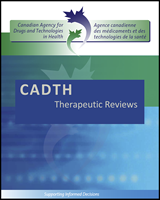Except where otherwise noted, this work is distributed under the terms of a Creative Commons Attribution-NonCommercial- NoDerivatives 4.0 International licence (CC BY-NC-ND), a copy of which is available at http://creativecommons.org/licenses/by-nc-nd/4.0/
NCBI Bookshelf. A service of the National Library of Medicine, National Institutes of Health.
Anticoagulation Monitoring and Reversal Strategies for Dabigatran, Rivaroxaban, and Apixaban: A Review of Clinical Effectiveness [Internet]. Ottawa (ON): Canadian Agency for Drugs and Technologies in Health; 2012 Apr.

Anticoagulation Monitoring and Reversal Strategies for Dabigatran, Rivaroxaban, and Apixaban: A Review of Clinical Effectiveness [Internet].
Show detailsNo evidence was found pertaining to strategies to identify over-anticoagulation states for patients taking dabigatran, rivaroxaban, or apixaban. The effects of dabigatran, rivaroxaban, and apixaban on commonly used coagulation assays have recently been examined.18–22 Some coagulation assays have been identified that correlate to the plasma concentration of the specific anticoagulant in a linear, dose-dependent fashion. Currently, it appears that many of these tests provide a qualitative measure of anticoagulation, as no references have been provided to set therapeutic ranges.10,23 Further limitations associated with these assays are lack of commercial availability for some of the assays, lack of standardization, and lack of validation.23–25 Additionally, the evidence-based guideline stated that there is no information linking plasma dabigatran levels and the risk of hemorrhage or the safety of surgery.16,17
The product monograph for dabigatran states that, in patients who are bleeding, the activated partial thromboplastin time (aPTT) test may be useful to assist in determining an excess of anticoagulant activity, despite its limited sensitivity. An aPTT greater than 80 seconds at trough (when the next dose is due) is associated with a higher risk of bleeding.5 This test is less sensitive to anticoagulant activity compared with thrombin time and ecarin clotting time tests,5,8,26 and the association between prolongation of aPTT and dabigatran plasma concentration has been reported to be curvilinear.22 The product monograph for rivaroxaban states that measuring the prothrombin time (PT) using the Neoplastin reagent may be useful in patients who are bleeding, to assist in determining an excess of anticoagulant activity.15 PT has been shown to increase in a concentration-dependent manner;19 however, no references have been specified to determine under- and over-anticoagulation states. The product monograph for apixaban states that anti-factor Xa activity exhibits a linear relationship with apixaban plasma concentration as measured by the Rotachrom assay.7 This strong linear correlation between anti-factor Xa activity and apixaban plasma concentration was reported in a study that used blood samples from 1,691 patients with acute coronary syndrome from the APPRAISE-1 study;21 however, no reference ranges are stipulated to determine anticoagulation level.
Currently, in the event of bleeding in patients taking warfarin, available reversal agents for anticoagulant activity include vitamin K, prothrombin complex concentrate, and fresh frozen plasma.11 Despite the ability of these agents to normalize INR relatively rapidly and effectively, it is unclear whether this correction in anticoagulation level confers benefits in patient outcomes in cases of severe bleeds (i.e., intracranial hemorrhage).27,28
Although one RCT13 and one cohort study14 were identified that evaluated strategies for rivaroxaban and dabigatran reversal, these studies failed to provide any relevant information that could be applied to manage patients experiencing bleeding in clinical practice. The RCT13 was conducted in 12 healthy volunteers who did not experience major or clinically relevant bleeding complications during the study. The effectiveness of PCC was measured by the ability of the procoagulant agent to restore laboratory markers to baseline levels following the administration of anticoagulant. The clinical meaningfulness of laboratory marker reversal is uncertain.29
The results from the small cohort study14 (N = 6) suggest that hemodialysis immediately following dabigatran administration can remove a fraction of the drug from the blood, but the relevance, practicability, and cost of this strategy for individuals taking dabigatran in clinical practice and experiencing bleeding is unknown.
Several conference abstracts30–39 and non-clinical studies40–42 were identified that provide information on emerging strategies to manage bleeding in patients taking dabigatran and rivaroxaban. The effects of these strategies are summarized for dabigatran and rivaroxaban in Appendices 1 and 2, respectively.
No published studies were identified that evaluated the cost of strategies to treat bleeding associated with the use of dabigatran, rivaroxaban, or apixaban. However, a conference abstract43 compared the cost of PCC for anticoagulation reversal for patients taking vitamin K antagonists with the cost of recombinant activated factor VIIa for anticoagulation reversal in patients taking new oral anticoagulants experiencing critical bleeding or requiring urgent surgery (summarized in Appendix 3).
- DISCUSSION - Anticoagulation Monitoring and Reversal Strategies for Dabigatran, ...DISCUSSION - Anticoagulation Monitoring and Reversal Strategies for Dabigatran, Rivaroxaban, and Apixaban: A Review of Clinical Effectiveness
- Homo sapiens G elongation factor mitochondrial 1 (GFM1), transcript variant 11, ...Homo sapiens G elongation factor mitochondrial 1 (GFM1), transcript variant 11, non-coding RNAgi|1750411863|ref|NR_164499.1|Nucleotide
Your browsing activity is empty.
Activity recording is turned off.
See more...